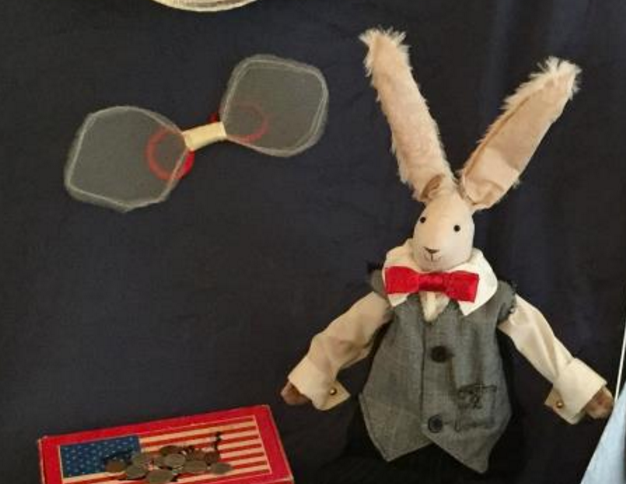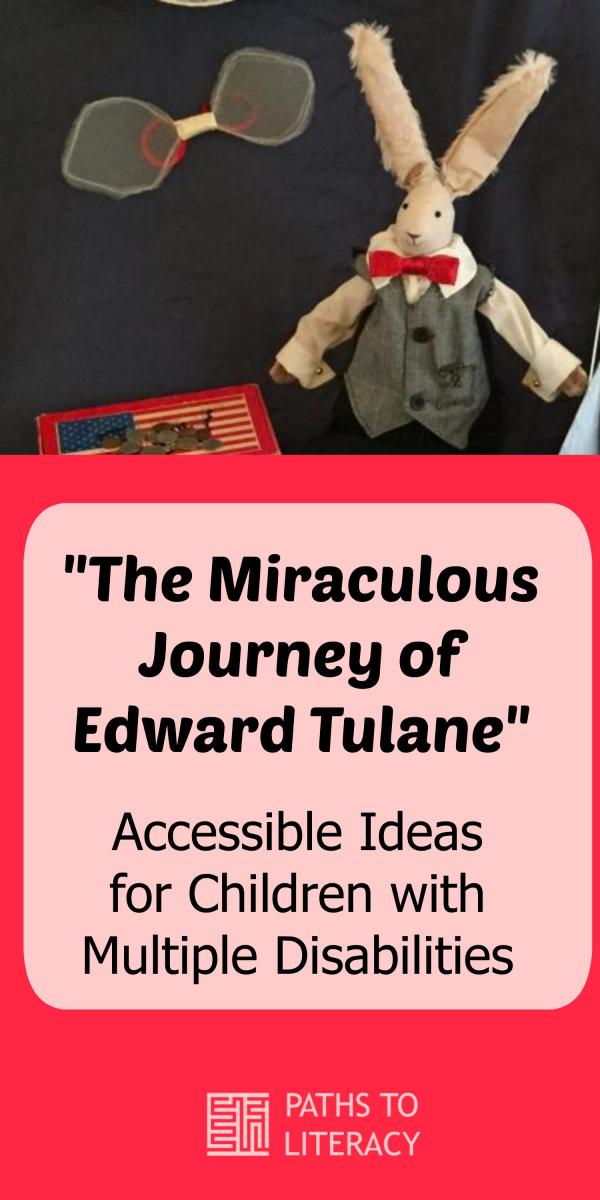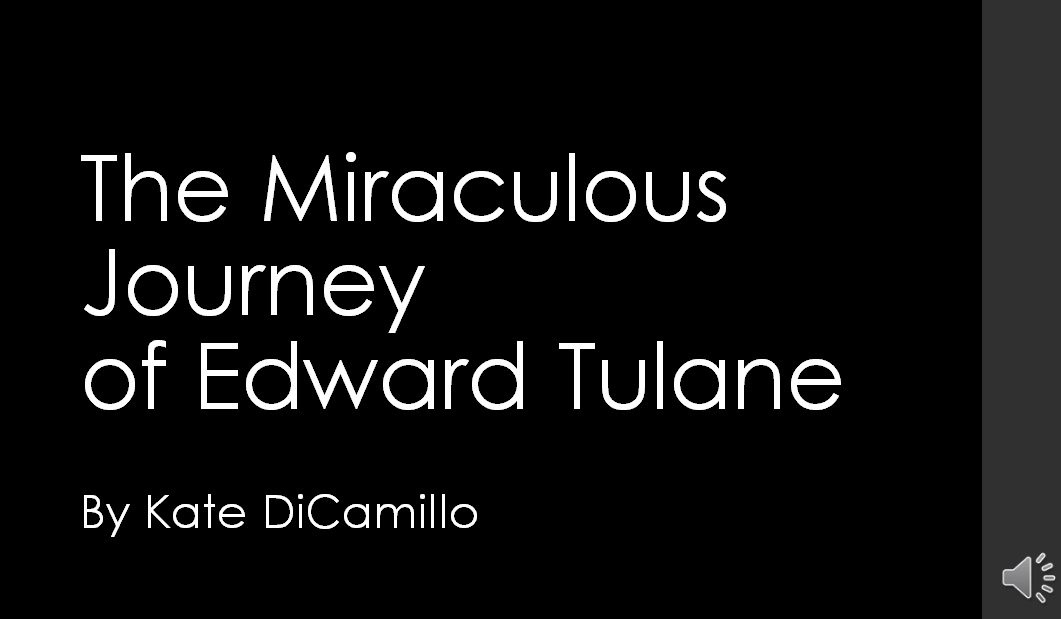"The Miraculous Journey of Edward Tulane": Accessible Ideas for Children with Multiple Disabilities
Submitted by Heather Collins on Apr 18, 2017

As part of the graduate coursework for Visual Impairments and Multiple Disabilities in the Teacher Preparation Program in Visual Impairments at the University of Kentucky, students were asked to complete four projects: Story Box, Picture Communication Symbols for Story Box, Tactile Communication Symbols, and Talking Book Project.
We are sharing them on Paths to Literacy and hope that others will use them! Please add your comments at the bottom of the page. This project is based on The Miraculous Journey of Edward Tulane by Kate Dicamillo.
Story Box:
Tangible Objects were put into a box that resembled a suitcase, since Edward was taking a journey. Those objects included:
- Edward (rabbit doll)
- China doll
- Pocket watch (traditional size)
- Pocket watch (doll size)
- Mirror
- Fishing net
- Apron
- Garbage (coffee grounds, piece of rubber tire, wadded up paper)
- Aluminum Pie Plates on strings
- Worn out gingham pillow
- Sticks with strings (marionette apparatus)
- Button box (cardboard pencil box)
- Coins
- Harmonica
- Wings
- Star
-
Edward’s outfits
- Suit with vest, socks and shoes
- Pink cotton dress
- Handkerchief pants with stocking cap sweater
- Red silk pajamas
- Ruffled shirt with blue pants
Background Knowledge:
This book is geared toward students in fourth through sixth grades, but could be enjoyed by older students as well. This age group would likely have background knowledge for the following items:
- rabbit
- doll
- net
- garbage
- pillow
- sticks
- coins
- clothes (Students may even be aware of the difference in materials, and that they may wear a cotton t-shirt to school on most days, but on special days, such as Easter, they may wear an outfit made of silk.)
However, students who would benefit from using the story box may have more severe needs, which may mean they may have had limited interaction with many of these objects. Therefore, students may need to build their knowledge and have prior experience with the following to best gain a true understanding of the events in this story:
- china doll – how fragile it is, and that it is less common because it’s more expensive
- Pocket watch
- reflection
- apron
- pie plates
- marionette apparatus
- harmonica
- wings (such as an angel’s wings)
Six Ideas for Implementation:
- Allow students to explore the items in the box prior to receiving any information from the story. Allow the students to make predictions about what the book may be about and what might happen in the story.
- Given access to all the tangible objects, the students could use the objects to retell the story.
- Allow students to identify one particular object they have had a previous experience with, and allow each student to share their personal experience. (For example, a student may discuss that a grandfather carried a pocket watch, or maybe smelling the coffee grounds reminds the student of a time that they visited a coffee shop.)
- Allow the students to use the tangible objects to identify various concepts such as characters or settings.
- Given three objects, allow the student to demonstrate sequencing skills by demonstrating which came first, next, and last in the story.
-
Allow students to use objects to answer comprehension questions. *This could be done either by giving the students access to all tangible objects, or for a student with more severe needs, by giving them only two or three objects from which to pick, essentially making it a real-life multiple choice scenario. Questions could include:
- When Edward looked at the window, what did he see?
- What did Edward have in his pocket?
- How did Edward get out of the ocean?
- Which object would Edward see Nellie wearing?
- What made banging sounds beside Edward when he was a scarecrow?
- How did Bryce make Edward “dance”?
- What did Bryce use to play music for Edward when he made him dance?
- What did people give Bryce to show that they enjoyed the show that he and Edward were putting on?
- Where did people put the coins?
- What was on Edward’s back when he wished he could fly up to see Sarah Ruth?
I would like to thank my mother, Emline Montgomery, for helping with this project. She devoted several hours to making most of Edward’s outfits, including his bandana pants, stocking sweater, purple ruffled shirt, blue pants, red silk pajamas outfit, and his suit, complete with vest, pants, shirt, and socks. She even searched until she was able to find Edward shoes that would fit.
Tactile Communication Symbols
The tactile communication symbols were cards that were created that would allow the student to communicate responses to questions about the story. These symbols move the students from concrete, real objects, to symbols for objects. The cards that were created were chosen because they give the most opportunity for the student to communicate answers to questions that could be asked about the story, reinforcing comprehension of the story. Cards have Velcro loop adhered to the backs so that they can be used with a felt display board when communicating responses to questions. The following are the cards that were included:
- Edward
- Abilene
- Nellie
- Sarah Ruth
Four “setting” cards:
- house (which can represent all the houses discussed in the story)
- ocean
- diner
- outside
Six “object” cards”
- pocket watch
- net
- garbage
- coins
- marionette
- star
Two “expansion” cards:
- sadness
- love
These cards would be utilized after the student has heard the story read, and has interacted with the tangible objects in the story box. Therefore, they should have background knowledge for most of the objects. Teachers may need to discuss, however, that rabbits have long ears and big feet, which would give the student a better understanding of the figurine that is used to represent Edward. Students may also need a reminder that a door is a wooden object that had a spherical knob, which is used to enter a house. They may need some experience with water, and that water has bubbles to better understand the “ocean” card. Students may also need to be reminded that a restaurant may have a hard edge and a tablecloth so they can best understand the “diner” card. Finally, students may need a reminder about the marionette apparatus since it is not a common, everyday object. There is a “life-sized” one in the story box, but may need direct instruction to help them comprehend that the one on the card is a miniature of the same object.
Implementation
After hearing the story read, and then exploring the tangible objects in the story box, the students would be introduced to the tactile cards. Background knowledge would be addressed for any students having difficulty understanding the symbols. Students would use the cards to complete an activity where they answer comprehension questions related to the story. Sample questions include:
- Who is the main character in the story?
- Where does the story begin?
- How does Edward feel when he gets kicked off the train?
- When Bryce takes Edward home, who does he give him to?
- Where does Edward land when he if flung overboard from the ship?
- When Lucy finds Edward, what is he laying on?
- When Sarah Ruth holds Edward, he said his body filled with warmth. What emotion is Edward feeling?
- When Bryce takes Edward to Memphis, he makes Edward “dance”. What did the people that enjoyed the show throw in the button box?
- At the end of the story, what does Edward see that makes him realize that the lady holding him is Abilene?
- When Edward reflects on his life, he realizes that he has been loved. Who are three characters that loved Edward?
Other ways of implementing the cards would include:
- The student could use the cards to identify the main character and supporting characters.
- The student could use the cards to identify some settings in the story.
- The student could use the cards to retell parts of the story.
- When given three cards, the student could identify which of those came first, next, and last in the story.
- The student could use the emotions cards to identify how characters felt at certain parts of the story.
Picture Communication Symbols
The picture communication symbols were cards that were created that would allow the student to communicate responses to questions about the story. These symbols move the students from concrete, real objects, to abstract ideas about objects. The cards that were created were chosen because they give the most opportunity for the student to communicate answers to questions that could be asked about the story, reinforcing comprehension of the story. Cards have magnets adhered to the backs so that they can be used with a metal display board when communicating responses to questions. The following are the cards that were included:
Five “character” cards:
- Edward
- Abilene
- Nellie
- Sarah Ruth
- Bryce
Four “places” cards:
- Abilene’s house
- Sarah Ruth’s house
- Neal’s Diner
- Doll Mender’s store
Cards which could be “places” or “things”:
- Ship
- Ocean
- Fishing boat
- Net
- Shelf
- Trash
- Train
- Garden
“Things” cards:
- Reflection
- Pocket watch
- Orange peels & coffee beans
- Stars
- Pie plate
- Harmonica
- Coins
“Emotions” cards:
- Sadness
- love
These cards would be utilized after the student has heard the story read, has interacted with the tangible objects in the story box, and has had experience working with the tactile cards. Therefore, they should have background knowledge for the pictures used with the cards.
Implementation
After hearing the story read, and then exploring the tangible objects in the story box, and completing activities included with the tactile cards, the students would be introduced to the picture communication cards. Background knowledge would be addressed for any students having difficulty understanding the images. Students would use the cards to complete an activity where they answer comprehension questions related to the story. Sample questions include:
- Where does Edward stay when Abilene goes to school?
- What does Edward see in the window when he sits and waits for Abilene to return?
- Abilene’s family is going on a trip. What will they be traveling on?
- Where does Nellie set Edward so that he can see everything in the room?
- Edward gets hung on a pole and used as a scarecrow. Where does this happen?
- When Edward is being used as a scarecrow, what other objects are banging together to make noise to scare away the crows?
- When Edward is thrown into the trash, what does he lay on?
- While living with Lucy and Bull, what does Edward look at each night?
- When Sarah Ruth dies, how does Edward feel?
- What does the doll on the doll mender’s shelf tell Edward he will have to learn to do?
Other ways of implementing the cards would include:
- The student could use the cards to identify the main character and supporting characters.
- The student could use the cards to identify some settings in the story.
- The student could use the cards to retell parts of the story.
- When given three cards, the student could identify which of those came first, next, and last in the story.
- The student could use the emotions cards to identify how characters felt at certain parts of the story.
Talking Book Project
I created a talking book utilizing the PowerPoint program for the book The Miraculous Journey of Edward Tulane. I summarized the book by giving the main character, Edward Tulane, an introduction, then highlighted only the major events that occurred. This book is written on a fourth grade level, and therefore it took a total of 19 slides to effectively communicate the important points of the story. All major events are discussed, but it allows a student to hear the story in the span of about 25 minutes. This would be beneficial to use remind students of the main events that happened in the story, prior to using the tactile or picture cards, so the story can be fresh in their minds.
I used a black background with large point, white Sans Serif font that would be best for students with visual issues. I also used only one picture per slide. Each picture was chosen based on the clarity and simplicity of the image that could clearly communicate the focus of each particular slide. I included sounds on some slides that added to the story. On the page that discussed that Edward owned a pocket watch, I included the sound of a ticking clock. When he was thrown overboard from a ship, I added a splashing sound, and when it was discussed that he was sinking deeper and deeper toward the ocean floor, the sound of bubbles is heard. At another point, when a train leaves Edward behind, there is a sound of a train whistle that can be heard, but sounds as though it is in the distance. In addition to the sounds, alternate text was added to several of the images which briefly describes the image that is included on the slide.






